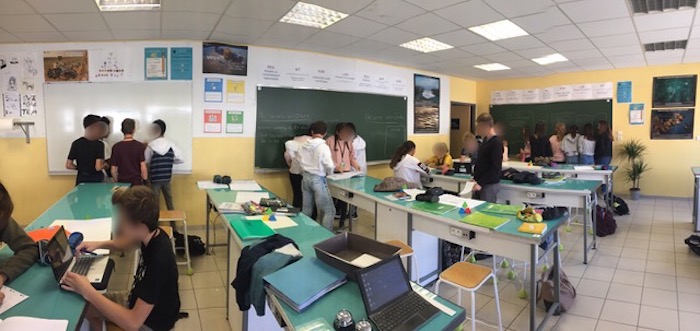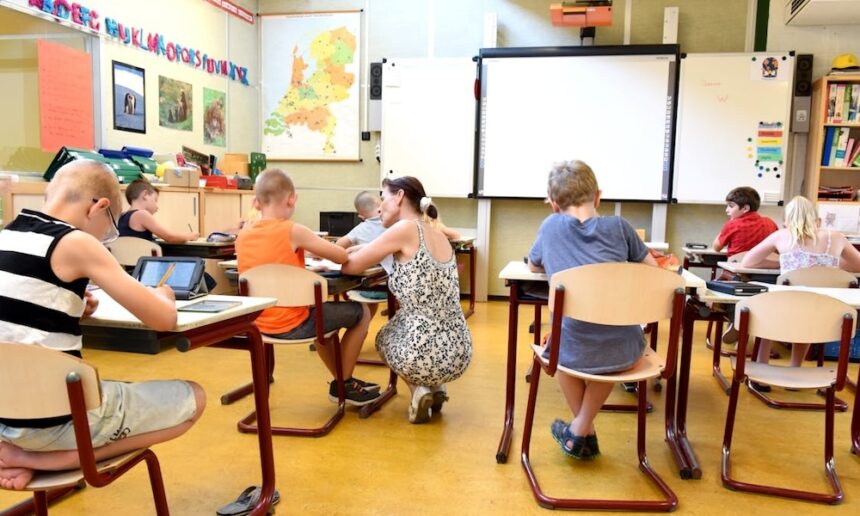The « bus-style classroom » setup, inherited from a tradition focused more on surveillance than on learning, still dominates. Desks, either single or double, are placed one behind the other in two or three rows, with aisles for the teacher to walk through. All desks face the blackboard and the teacher’s desk, mimicking the traditional exam setup, from middle school to the baccalaureate and competitive exams.
While architects and urban planners are concerned with how schools are physically structured, the classroom itself, as a place of learning and social interaction, raises questions about how spatial arrangements impact cognitive processes and interpersonal relationships.
How does classroom layout affect learning? What does it reveal about the educational philosophies driving teachers? How does spatial organization influence students’ relationship with knowledge? How does the physical setup affect the teacher’s authority?
Viewing the Classroom as a Social Space
In elementary schools, students spend about six hours a day in their classroom. The mission of schools today goes beyond just imparting knowledge to the younger generation; they are also tasked with educating and shaping the citizens of tomorrow.
In this context, the classroom must be viewed as a space for learning the rules of communal life. Certain educational practices significantly contribute to this social development. The « democratic socialization » championed by Célestin Freinet, a key figure in progressive education, is one such example. This philosophy includes practices like electing class representatives, creating classroom rules, making collective decisions about behavior and potential consequences, giving students a voice, discussing important topics, and involving both students and teachers in decision-making.
These activities help young children integrate into social life. Similarly, reorganizing classroom spaces to align with these educational goals also supports this process. Changing the arrangement of desks depending on the activity not only alters the physical space but also the relationships between students and between students and the teacher.

As a micro-society, the classroom is one of the first places where children experience social interactions beyond the family, with the teacher acting as the mediator between the child and their peers. According to educational psychologist Marcel Postic, “The educator’s role is to help decipher signs and structure internal life. They mediate between the individual and society, guiding children to understand the rules of the social group they belong to.”
In traditional educational settings, where the bus-style classroom dominates, the teacher enforces the rules. In progressive pedagogies, the teacher ensures that the rules are followed, rather than deciding them alone in an authoritarian manner.
In this context, the teacher’s authority becomes one that encourages students to engage, think, experiment, and make mistakes within a framework that the teacher upholds. The teacher does not impose authority but rather puts it at the service of the students, as Marcel Postic suggests.
The authority that allows students to move within the space according to shared rules is tied to how learning and cognitive approaches are structured.
Adapting Spaces to Educational Goals
Criticizing the « bus-style » classroom might give the impression that this setup should be entirely avoided, as if adhering to it makes a teacher bound to a traditional and conservative view of education. However, that’s not the case.
This layout can be effective when aligned with specific educational goals: for instance, when delivering information or ensuring everyone receives the same instruction simultaneously. Whether it’s written on the board, which all the desks face, or the teacher is speaking clearly to the entire class, this configuration can be appropriate.
However, this setup is not suitable when the goal is to engage students in « socio-cognitive conflict » where they must collectively solve problems by building hypotheses, arguing, and debating to construct new knowledge that would be difficult to develop alone. In such cases, grouping students in clusters of 4 or 5 is ideal.
For debates or project work, U-shaped or rectangular table arrangements work well. These setups encourage interaction among participants, allowing everyone to see and speak to each other, discuss ideas, and engage in collective decision-making, all under the guidance of the teacher.
The classroom should be able to transform in various ways: with desks arranged in a U-shape, in pairs, in small groups, with fixed or mobile boards, reading or computer corners (with headphones), and even a large table at the back of the room. Check out this video on the innovative pilot high school in Jaunay-Marigny, France.
These spatial variations are not valuable in themselves but are only useful if they support specific educational goals. Each layout has its relevance, provided it aligns with the learning methods being promoted.
It’s clear that the point isn’t to prescribe one single spatial arrangement that works for all educational or socio-cognitive objectives. Instead, the goal is to show how the layout of the classroom, the social life of its members, and learning objectives are interconnected.
Since the late 20th century, schools have embraced this reflection on classroom spaces, with education researchers exploring the topic and future teachers being trained in it. Although the flexible classroom model is becoming more common, the traditional model still dominates.
Nevertheless, rethinking spaces, furniture, and shared moments in this educational and social environment is essential for ensuring the coherence and success of the classroom’s mission.
Cécile Goï, Emeritus Professor, University of Tours
This article is republished from The Conversation under a Creative Commons license. Read the original article.
Explore more on this topic in our articles about the flipped classroom.








